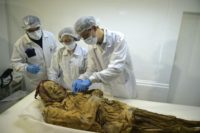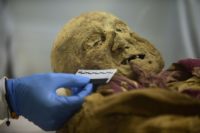The naturally mummified remains of an adult male found in the town Guano, in Ecuador’s Chimborazo Province, is being studied to learn about the spread of rheumatoid arthritis.
 The Guano Mummy was discovered after an earthquake struck the town on August 5th, 1949. In the rubble of the Asunción Church, rescuers found the well-preserved remains of a man wedged between two of only three sections of walls that remained of the 400-year-old church. The man was positioned vertically, as if standing, between the walls. He had not deliberately mummified, and neither was the mummified mouse found next to him. It seems the body was sprinkled with lime to speed decomposition but instead the dry, cold conditions preserved his tissues (and those of the unfortunate rodent) in excellent condition. His clothing also survived in remarkably fine fettle. There was a purple scarf wrapped around his jaw (perhaps to keep his mouth from gaping open) and a long white robe covering his body.
The Guano Mummy was discovered after an earthquake struck the town on August 5th, 1949. In the rubble of the Asunción Church, rescuers found the well-preserved remains of a man wedged between two of only three sections of walls that remained of the 400-year-old church. The man was positioned vertically, as if standing, between the walls. He had not deliberately mummified, and neither was the mummified mouse found next to him. It seems the body was sprinkled with lime to speed decomposition but instead the dry, cold conditions preserved his tissues (and those of the unfortunate rodent) in excellent condition. His clothing also survived in remarkably fine fettle. There was a purple scarf wrapped around his jaw (perhaps to keep his mouth from gaping open) and a long white robe covering his body.
After its discovery, the mummy was moved to the town library where it was displayed in less than adequate conditions which caused some deterioration of the organic remains. In 2003, a team of researchers from the US did a thorough study of the mummy, X-raying and carbon-dating it to the 16th century. The date coupled with archival research pointed to a possible candidate for the identity of the mummy: Fray Lázaro de la Cruz de Santofimia, a Franciscan monk who traveled to Guano from Spain to take charge of the religious community there.
Asunción Church was built between approximately 1560 and 1572, commissioned by the Franciscan missionaries who were evangelizing the indigenous Puruhá culture. Later a monastery and cemetery would be built next to the church. Fray Lázaro’s position as the first guardian of the church and monastery could have been the reason he was buried in such an unusual position and location, standing guard over his charges for eternity, as it were.
French pathologist Dr. Philippe Charlier and his team spent two days studying the mummy and taking samples at the laboratory of the National Institute of Cultural Heritage in Quito. One major draw is the evidence of rheumatoid arthritis found in the surviving tissue.
Rheumatoid arthritis was first found in America before the arrival of Christopher Columbus.
Dr Charlier explained: “The mummy of Guano may be the link missing that will allow us to understand how this disease, which was originally American, then became a global disease by hybridisation, by the confrontation between two worlds.”
 The examination has found a likely cause of death: a chin fistula that became infected and caused fatal sepsis.
The examination has found a likely cause of death: a chin fistula that became infected and caused fatal sepsis.
Charlier’s study will also perform a new radiocarbon analysis and DNA analysis (RA is associated with several genetic markers). The dating and genetic testing may help confirm or deny the mummy’s identity. He questions the Fray Lázaro identification because the man was not dressed in the usual Franciscan garb — the textiles are more expensive than the brown homespun of the monk’s habit — nor was he interred with expected Christian accouterments like a rosary and coffin.
“How rheumatoid arthritis, which was originally American, became a global disease by hybridisation, by the confrontation between two worlds.” ?!? –Is it really the case that inflammation and attrition where so utterly unheard of in Europe? Did not already poor Ötzi suffer from an early stage of rheumatoid arthritis? Is it a particular bacterial strain that was possibly and seemingly unknown to Europe?
I too am baffled by this. See link below. Rheumatoid arthritis as far as I know is an autoimmune disease and thus in no way could hybridize?????? It is not caused by a virus or bacteria.
It does seem that one of the environmental triggers of the disease may be smoking, so may account for greater prevalence of the disease in the New World before smoking and tobacco became known in the Old. Or possible another type of trigger may have transferred from the New to the Old World, but RA itself is still considered an autoimmune disease and genetics are in important factor.
From the linked article:
CURRENT HYPOTHESIS
RA generally begins to manifest in individuals between the ages of 30 and 65.57 The estimated average life expectancy was just under 30 years when RA was first described in the year 1800.58 Therefore it is possible that individuals who would have developed RA in ancient times died before the onset of the disease. This could partly explain why RA may have been much less common in previous centuries. Combined with the aforementioned paleopathological evidence showing the prevalence of RA in antiquity, a reasonable conclusion seems to be that RA was problematic for our ancestors in ancient times, but likely for very few of them.
One unresolved question is which generation of ancestors we are talking about. The New World to Old World concept proposes that an infectious trigger was transferred from the New World to Europe via trade goods (e.g. smoking tobacco), contaminated supplies, or travelers who picked up RA-inducing bacteria or viruses. Despite the plausibility of many of these arguments, discoveries of skeletons demonstrating RA in the Old World prior to the discovery of the Americas suggests that these transferred environmental (and perhaps also genetic) factors were not absolute prerequisites for the development of RA.
By combining the conclusions from paleopathological studies with those from advanced immunological and genetic analyses, a modified and updated version of the Ancient Origin view now stands as the best-supported theory concerning the historical epidemiology of RA. The current hypothesis consists of the following principles:
RA is not a disease of recent origin, and was both present and problematic hundreds, possibly thousands of years ago, potentially with a geographic distribution distinct from its current profile.
RA occurs as a response to an environmental stimulus or stimuli experienced by genetically susceptible individuals.
The identities and origins of these stimuli or inciting events are still incompletely known, although tantalizing clues have emerged.
Distinct environmental triggers may be important in subsets of patients with RA. For example, smoking may be a more important risk factor in RA patients who carry an MHC allele that encodes the shared-epitope and who have autoantibodies to citrulline-containing proteins. Thus, the historical analysis of RA needs to incorporate the likely possibility that what we currently define as RA is more than one disease.
This framework allows research to be directed towards a more expanded set of possible etiological causes that may have been overlooked if one adheres strictly to any of the three previously held hypotheses concerning the history of RA. Potentially, an integration of molecular insights and historical epidemiology may provide new clues for identifying the etiology of RA.
link:https://www.ncbi.nlm.nih.gov/pmc/articles/PMC3119866/
Turns out there’s a lot of controversy regarding whether humans developed RA in ancient times, or whether RA was transferred from the New World to the Old in the age of explorers, or if RA is a purely modern disease. The incomplete state of many ancient skeletons, and damage due to passing time, are confounding. I lean towards RA being an ancient disease. This article gives more detail:
https://www.ncbi.nlm.nih.gov/pmc/articles/PMC3119866/